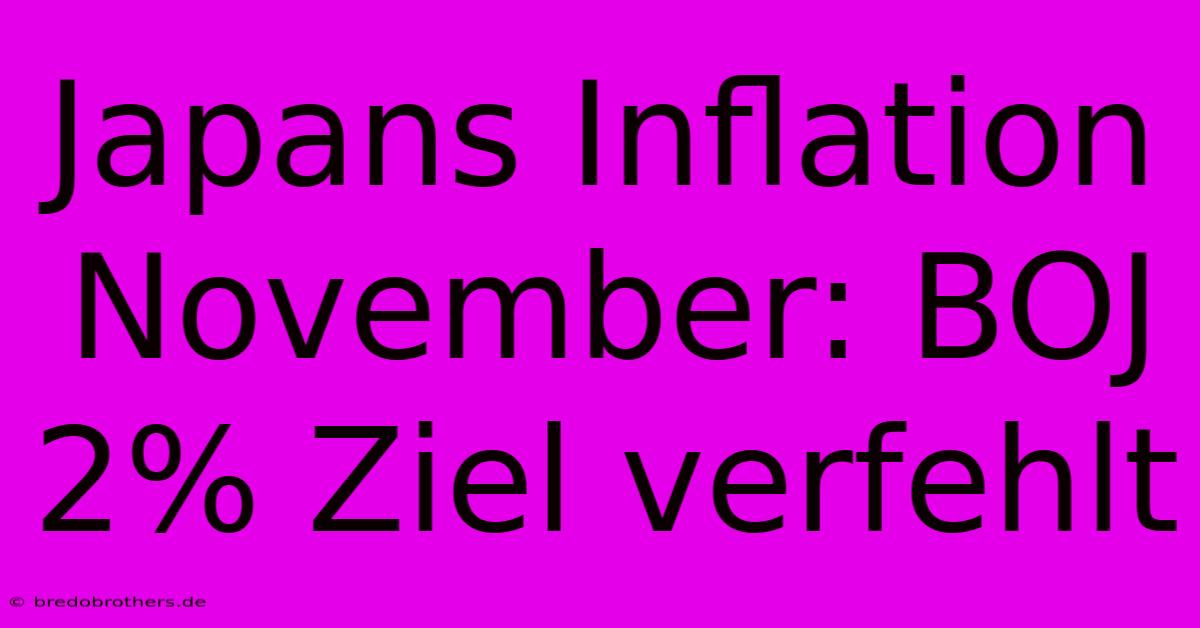Japans Inflation November: BOJ 2% Ziel Verfehlt

Discover more detailed and exciting information on our website. Click the link below to start your adventure: Visit Best Website Japans Inflation November: BOJ 2% Ziel Verfehlt. Don't miss out!
Table of Contents
Japans Inflation November: BOJ's 2% Ziel verfehlt – Ein Blick hinter die Kulissen
Hey Leute,
let's talk about Japan's economy, specifically the inflation numbers for November. The Bank of Japan (BOJ), they've been aiming for a 2% inflation rate for ages, right? Well, spoiler alert: they missed it again. This isn't exactly breaking news, but it's a huge deal and something that's been bugging me for a while. I mean, this whole thing is super complicated, but I'll try to break it down in a way that even I can understand.
November's Inflation Numbers: A Deep Dive (Sort Of)
So, November's inflation figures came out, and... yeah, they weren't great for the BOJ's 2% target. I'm not an economist, okay? But from what I've gleaned from various articles and endless scrolling through news websites, the core inflation (excluding fresh food and energy prices) fell short. It was, like, way below 2%. I saw one report that put it around 0.2% or something. Don't quote me on that exactly, though – I've got a terrible memory, and details get fuzzy.
The thing is, this isn't just some random number. This impacts everything. Think pensions, wages, investment strategies... the whole shebang. It's a reflection of the overall economic health of Japan, and frankly, it’s a bit of a bummer.
My Personal Struggle with Understanding Inflation
Honestly, I've always struggled to fully grasp the nuances of inflation. It's one of those things that sounds simple in theory – prices going up – but the reality is far more complex. I remember once, years ago, I was trying to budget for a trip to Japan. I completely underestimated the impact of inflation on the cost of living. Let's just say, my ramen budget was significantly overshot. It was a major learning experience – and not a fun one.
That's why I try to stay updated on things like this. It's not always easy, especially with the technical jargon. But even a basic understanding helps with making better financial decisions.
Why the BOJ's Target Remains Elusive
The reasons behind Japan's persistent struggle to reach its 2% inflation target are multifaceted. It's not just one thing. Economists will tell you it's a complex interplay of factors, like:
- Weak consumer spending: People aren't spending as much, which reduces demand, putting downward pressure on prices. Makes sense, right? Less demand, less pressure on prices to rise.
- A strong yen: A strong yen can make imports cheaper, also keeping inflation down.
- Demographic shifts: Japan's aging population is a huge factor, influencing consumer behavior and economic growth.
Understanding these elements is key to understanding why the BOJ is having such a tough time meeting its target.
What Does This Mean for the Future?
Honestly? I don't have a crystal ball. Predicting the future of the Japanese economy is way above my pay grade. However, I do know that the BOJ will likely continue to implement monetary policies to try and stimulate inflation. We'll probably see more of what they've been doing – tweaks to interest rates and other monetary tools.
The key takeaway here is that staying informed about economic news, even if it's complex, is really important. Keep an eye on news sources (but be critical – not everything you read is gospel!), and maybe, just maybe, you'll avoid my ramen budget disaster.
Disclaimer: I'm not a financial advisor. This is just my personal take based on what I’ve read and learned. Always consult with a professional for financial advice.

Thank you for visiting our website wich cover about Japans Inflation November: BOJ 2% Ziel Verfehlt. We hope the information provided has been useful to you. Feel free to contact us if you have any questions or need further assistance. See you next time and dont miss to bookmark.
Featured Posts
-
China Kartoffelforschung Klimawandel
Nov 28, 2024
-
Remis In Girona Sturm Auf Championskurs
Nov 28, 2024
-
Hoehere Inflation In Japan Neue Regeln
Nov 28, 2024
-
Calibre Meldet Starke Mineralisierung In Limon
Nov 28, 2024
-
Sturm Erfolgreich Youth League
Nov 28, 2024
